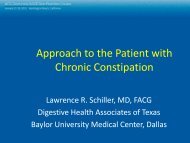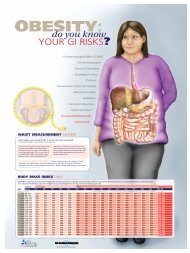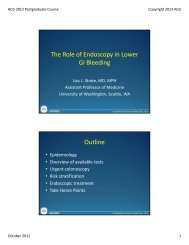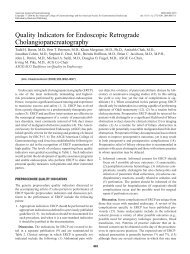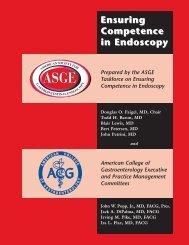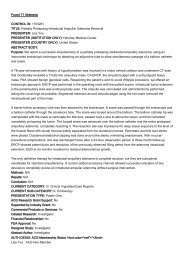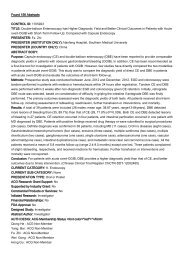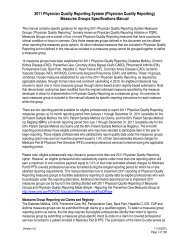Pregnancy
Pregnancy
Pregnancy
Create successful ePaper yourself
Turn your PDF publications into a flip-book with our unique Google optimized e-Paper software.
Liver Diseases in <strong>Pregnancy</strong><br />
................................................................................................................................................................<br />
Pruritus is the main feature of IHCP and is present in<br />
all patients. Pruritus can be disabling and most commonly<br />
involves the hands and feet although it can be<br />
generalized. Jaundice occurs 2-4 weeks after the onset<br />
of pruritus in 10%-25% of affected women. Other<br />
symptoms include nausea, vomiting and abdominal<br />
pain.<br />
Laboratory assessment shows a marked elevation of<br />
alkaline phosphatase and serum bile acids. Serum<br />
transaminases are typically mildly elevated. Total and<br />
direct bilirubin levels are increased in up to one-third<br />
of patients but total bilirubin levels are rarely greater<br />
than 5 mg/dl. Interestingly serum level of Gamma<br />
Glutamyl Transferase GGT is normal or slightly elevated.<br />
Liver biopsy is usually not needed to make the diagnosis<br />
of IHCP. Typical histologic findings include centrilobular<br />
cholestasis, canaliculi containing bile plugs,<br />
and bile pigment in hepatocytes. Inflammation and necrosis<br />
are not usually observed in the portal tracts.<br />
Therapy of IHCP is aimed at ameliorating the pruritus<br />
in the mother and improving fetal outcome. Cholestyramine<br />
has been used in the past for the management<br />
of pruritus but was found to worsen fetal outcome by<br />
increasing the risk of fetal hemorrhage due to vitamin<br />
K deficiency and should be avoided.<br />
Fetal hemorrhage has been<br />
reported in association<br />
with IHCP due to vitamin K<br />
deficiency.<br />
Fetal hemorrhage has been reported in association<br />
with IHCP due to vitamin K deficiency. Thus all patients<br />
with IHCP with prolonged cholestasis should be<br />
monitored with prothrombin time and vitamin K deficiency<br />
corrected.<br />
Ursodeoxycholic acid (UDCA) (FDA Category B) has<br />
been tested in randomized clinical trials and is considered<br />
the treatment of choice in pregnant women with<br />
IHCP due to its documented efficacy and safety to the<br />
fetus after the first trimester. UDCA is a hydrophilic<br />
bile acid that modifies the bile acid pool composition<br />
in replacing toxic bile acids. It decreases the passage<br />
of maternal bile acids to the fetal placental unit and<br />
improves the function of bile acid transporters. When<br />
given to women with severe symptoms of IHCP, at 1<br />
gram divided into three daily doses, significant relief<br />
from pruritus and marked reduction of serum bile acids<br />
occured after one week of therapy. Liver test abnormalities<br />
were also noted to be improved without<br />
maternal or fetal toxicity. 12<br />
Maternal outcome is favorable in IHCP although poor<br />
weight gain due to anorexia and vomiting can occur.<br />
The pruritus disappears within 48 hours of delivery in<br />
most cases. Biochemical abnormalities and liver histology<br />
resolve after several weeks. Long-term followup<br />
studies have shown that women with IHCP are at<br />
increased risk for gallstone related hepatobiliary disorders.<br />
13<br />
Fetal outcome is less benign however, with increased<br />
risk of premature delivery, neonatal death (stillbirth),<br />
and meconium staining of amniotic fluid. Fetal mortality<br />
in the absence of therapy averages 11-20%. The<br />
mechanism of fetal complications associated with<br />
IHCP is not known although it has been proposed that<br />
elevated serum bile acids may stimulate uterine muscle<br />
contractions and may lead to fetal anoxia. Because<br />
of the potential for serious fetal complications in pregnant<br />
women with IHCP, it is recommended that aggressive<br />
monitoring for fetal distress during the third<br />
trimester should be done. The role of UDCA on fetal<br />
outcome is not clearly established, and while elevated<br />
serum bile acid levels > 40 micromol/L have been reported<br />
in association with more severe disease and fetal<br />
distress, babies should be delivered promptly after<br />
lung maturity regardless of bile acid levels to avoid<br />
fetal compromise.<br />
...................................................................................................................................................................................<br />
37





